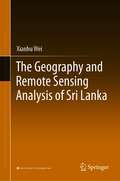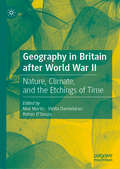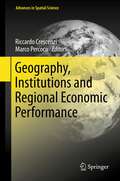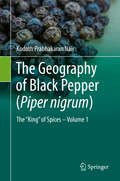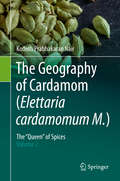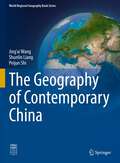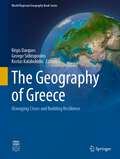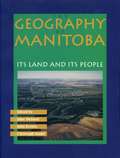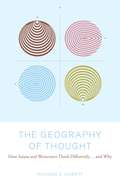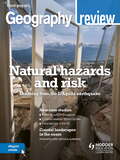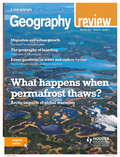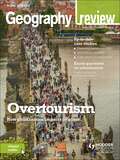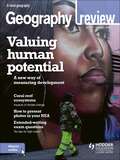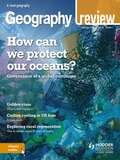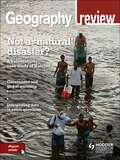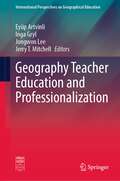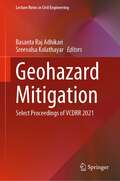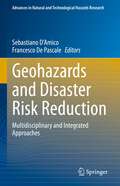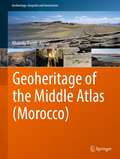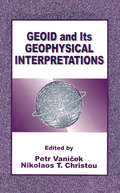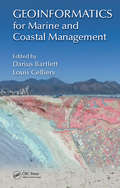- Table View
- List View
The Geography and Remote Sensing Analysis of Sri Lanka
by Xianhu WeiThis book presents a survey, dynamic monitoring and comprehensive analysis of Sri Lanka’s land, vegetation, surface water, ocean and other environmental resources, as well as its economic, transportation, urban, agricultural and tourism development. It offers readers accurate, systematic and comprehensive information on Sri Lanka’s ecological setting and socio-economic development. It also sheds light on policies for the protection of the environment and biodiversity.
Geography for Life: National Geography Standards, 1994
by Sarah W. Bednarz Norman C. Bettis Richard G. Boehm Roger M. DownsThe inclusion of geography as a core subject in Goals 2000: Educate America Act (Public Law 103-227) is the culmination of a decade of reform in geography education. There is now a widespread acceptance among the people of the United States that being literate in geography is essential if students are to leave school equipped to earn a decent living, enjoy the richness of life, and participate responsibly in local, national, and international affairs.
Geography in Britain after World War II: Nature, Climate, and the Etchings of Time
by Max Martin Vinita Damodaran Rohan D’SouzaContemporary anxieties about climate change have fueled a growing interest in how landscapes are formed and transformed across spans of time, from decades to millennia. While the discipline of geography has had much to say about how such environmental transformations occur, few studies have focused on the lives of geographers themselves, their ideologies, and how they understand their field. This edited collection illuminates the social and biographical contexts of geographers in postwar Britain who were influenced by and studied under the pioneering geomorphologist, A. T. Grove. These contributors uncover the relationships and networks that shaped their research on diverse terrains from Africa to the Mediterranean, highlighting their shared concerns which have profound implications not only for the study of geography and geomorphology, but also for questions of environmental history, ecological conservation, and human security.
Geography, Institutions and Regional Economic Performance
by Marco Percoco Riccardo CrescenziThe book aims to present "traditional features" of regional science (as geographical concepts and institutions), as well as relatively new topics such as innovation and agglomeration economies. In particular it demonstrates that, contrary to what has been argued by recent economics literature, both geography and institutions (or culture) are relevant for local development. In fact, these phenomena, along with the movement of goods and workers, are among the main reasons for persisting development differentials. These intriguing relationships are at the heart of the analysis presented in this book and form the conceptual basis for a promising institutional approach to economic geography.
The Geography of Black Pepper (Piper nigrum): The "King" of Spices – Volume 1
by Kodoth Prabhakaran NairThis book considers all aspects of black pepper from its growth, as a flowering vine, to how the dried fruit (peppercorn) is used as a spice and traded as a commodity. It is the economic mainstay of several India states and, principally, in Kerala State, with the Indian subcontinent being the largest black pepper producer. Indonesia has also emerged as a large producer of black pepper. Black pepper commands a leading position among the spices and has an immense commercial importance to world trade, finding its way onto the dining table of millions around the world, on the European and North American continents, and Japan. The use of black pepper ranges from a simple dietary component and flavour enhancer, to that of a spice with huge pharmacological benefits.
The Geography of Cardamom (Elettaria cardamomum M.): The "Queen" of Spices – Volume 2
by Kodoth Prabhakaran NairThis book catalogues the multi-scale impact of agronomy and economy on Cardamom, known as the “Queen” of spices. Cardamom is the second most important spice crop in the world, after Black pepper, known as the “King” of spices. Spices were the symbols of luxury and royalty, and cardamom was used in the manufacture of perfumes during the Greek and Roman times. It became one of the most important Oriental spices used in both Greek and Roman cuisine as well as its pharmacological applications. The book is divided into 15 chapters and concentrates on aspects of cardamom production and processing, the taxonomic aspects of cardamom, chemistry, pathology, entomology and is concluded with the future of cardamom. Special emphasis is given to the utility of “The Nutrient Buffer Power Concept”, a soil management technique in precise fertilizer management, especially with regard to Potassic fertilizers in cardamom production.
The Geography of Contemporary China (World Regional Geography Book Series)
by Jing’ai Wang Shunlin Liang Peijun ShiThis textbook provides a comprehensive and very detailed insight into Chinese Contemporary Geography in English. It documents the geographical issues associated with China's rapid growth. Since initiating the reforms and open policy, China has achieved tremendous success. China's rapid growth is now a driving force in the global economy and is achieving unprecedented rates of poverty reduction. However, China also faces a number of sustainability and emerging challenges associated with rapid growth such as growing regional disparities in terms of per capita income and social-economic development, sustainable resource development, and issues related to regional and global economic integration. In addition, rapid economic growth has also brought about major challenges such as resource shortages, ecological and environmental destruction, land degradation and frequent disasters. This book presents the authors’ reflections. This lavishly illustrated book covers physical geography, history, and economic and political systems of the world's most populous country. The major focus is on geographical issues in China's contemporary development: agriculture, population, urbanization, resource and energy, and environment. The lead author of the book has taught relevant courses in China for three decades, and authored and edited multiple textbooks for Chinese students. This book will appeal to undergraduate students of geography and related disciplines with a regional focus on China and to the general reader who wants to learn different geographical aspects of modern China with little academic background in geography.
The Geography of Greece: Managing Crises and Building Resilience (World Regional Geography Book Series)
by Régis Darques George Sidiropoulos Kostas KalabokidisDuring the last few years, Greece has become a subject of increasing attention worldwide. Once praised for its ability to innovate and reform during the EU integration process, applauded for its remarkable job in managing the 2004 Olympics, the country fell into a financial crisis of unprecedented magnitude in 2008. Much has been said on this matter, and amid the morass of information a staggering number of untruths have been disseminated.In fact, the challenges of vulnerability and the paradigms of adaptation go way beyond finance and economy in Greece. Mega-fires, earthquakes, landslides and floods, migrations, sociopolitical upheavals, and armed conflicts generate emergency situations repeatedly. Because of its bridging role between natural and social sciences, geography can provide insights into the entire breadth of hazardous and chaotic events driving adaptation and change. Against all these threats, Greece has developed an enhanced resilience capacity. The purpose of this book is to help unravel the complexities of a fascinating country beyond clichés.This book is intended for students, researchers, scholars, and engineers interested in geography, land planning, urban studies, and environmental management. The crises issue intended as a guideline allows widening the audience to include the media, governmental and non-governmental agencies, and the public at large.
The Geography of Manitoba: Its Land and its People
by John Welsted John Everitt Christoph StadelManitoba is more than one of Canada's three prairie provinces. Encompassing 649,950 square kilometres, its territory ranges from Canadian Shield to grassland, parkland, and subarctic tundra. Its physical geography has been shaped by ice-age glaciers, while its human geography reflects the influences of its various inhabitants, from the First Nations who began arriving over 9,000 years ago, to its most recent immigrants. This fascinating range of geographical elements has given Manitoba a distinct identity and makes it a unique area for study. Geography of Manitoba is the first comprehensive guide to all aspects of the human and physical geography of this unique province. Representing the work of 47 scholars, and illustrated with over 200 maps, diagrams, and photographs, it is divided into four main sections, covering the major areas of the province's geography: Physical Background; People and Settlements; Resources and Industry; and Recreation.As well as studying historical developments, the contributors to Geography of Manitoba analyse recent political and economic events in the province, including the effect of federal and provincial elections and international trade agreements. They also comment on future prospects for the province, considering areas as diverse as resource management and climatic trends.
The Geography of the United States
by Core Knowledge FoundationFrom the CORE KNOWLEDGE FOUNDATION, which brought you the popular "What Your ___ Grader Needs to Know" series. THE GEOGRAPHY OF THE UNITED STATES reinforces map and globe skills as young readers learn about the geographic characteristics of different regions of the United States: New England, Mid-Atlantic, South, Midwest, Great Plains, Rocky Mountain, Southwest, and West Coast. The book explores each region's climate, natural resources, culture, and other distinctive characteristics. Paperback. 77 pages. ** Part of the CORE KNOWLEDGE HISTORY AND GEOGRAPHYTM (CKHG) series in world and American history and geography, integrating topics in civics and the arts. CKHG books offer engagingly written text with many color illustrations, maps, vocabulary sidebars, and a glossary. Related materials (Teacher Guides and Timeline Cards) are also published by the Core Knowledge Foundation. In general, CKHG books are appropriate for young readers from the upper elementary grades through middle school.
The Geography of Thought
by Richard NisbettEveryone knows that while different cultures may think about the world differently, they use the same equipment for doing their thinking. Everyone knows that whatever the skin color, nationality, or religion, every human being uses the same tools for perception, for memory, and for reasoning. Everyone knows that a logically true statement is true in English, German, or Hindi. Everyone knows that when a Chinese and an American look at the same painting, they see the same painting.But what if everyone is wrong?When psychologist Richard E. Nisbett showed an animated underwater scene to his American students, they zeroed in on a big fish swimming among smaller fish. Japanese subjects, on the other hand, made observations about the background environment -- and the different "seeings" are a clue to profound underlying cognitive differences between Westerners and East Asians. For, as Professor Nisbett shows in The Geography of Thought, people actually think about -- and even see -- the world differently because of differing ecologies, social structures, philosophies, and educational systems that date back to ancient Greece and China and that have survived into the modern world. As a result, East Asian thought is "holistic" -- drawn to the perceptual field as a whole and to relations among objects and events within that field. By comparison to Western modes of reasoning, East Asian thought relies far less on categories or on formal logic; it is fundamentally dialectic, seeking a "middle way" between opposing thoughts. By contrast, Westerners focus on salient objects or people, use attributes to assign them to catergories, and apply rules of formal logic to understand their behavior. The Geography of Thought documents Professor Nisbett's groundbreaking international research in cultural psychology, a series of comparative studies both persuasive in their rigor and startling in their conclusions, addressing questions such as: Why did the ancient Chinese excel at algebra and arithmetic, but not geometry, the brilliant achievement of such Greeks as Euclid? Why do East Asians find it so difficult to disentangle an object from its surroundings? Why do Western infants learn nouns more rapidly than verbs, when it is the other way around in East Asia? What are the implications of these cognitive differences for the future of international politics? Do they support a Fukuyamaesque "end of history" scenario or a Huntingtonian "clash of civilizations"?From feng shui to metaphysics, from comparative linguistics to economic history, a gulf separates the children of Aristotle from the descendants of Confucius. At a moment in history when the need for cross-cultural understanding and collaboration have never been more important, The Geography of Thought offers both a map to that gulf and a blueprint for a bridge that might be able to span it.
The Geography of Thought: How Asians and Westerners Think Differently... and Why
by Richard E. NisbettWhen psychologist Richard E. Nisbett showed an animated underwater scene to his American students, they zeroed in on a big fish swimming among smaller fish. Japanese observers instead commented on the background environment -- and the different "seeings" are a clue to profound cognitive differences between Westerners and East Asians. As Nisbett shows in The Geography of Thought, people think about -- and even see -- the world differently because of differing ecologies, social structures, philosophies, and educational systems that date back to ancient Greece and China. The Geography of Thought documents Professor Nisbett's groundbreaking research in cultural psychology, addressing questions such as: Why did the ancient Chinese excel at algebra and arithmetic, but not geometry, the brilliant achievement of such Greeks as Euclid? Why do East Asians find it so difficult to disentangle an object from its surroundings? Why do Western infants learn nouns more rapidly than verbs, when it is the other way around in East Asia? At a moment in history when the need for cross-cultural understanding and collaboration have never been more important, The Geography of Thought offers both a map to that gulf and a blueprint for a bridge that might be able to span it.
Geography Review Magazine Volume 32, 2018/19 Issue 1
by Hodder Education MagazinesThis A-level geography magazine provides topical articles by experts in the field, specifically written for students to help them gain the highest grades. With up-to-date articles and case studies, it also includes advice on the NEA and approaching exam questions.ContentsHazard perception and risk: learning from the L'Aquila earthquake Noel Castree Question and answer Coastal landscapes and change Geographical ideas Representation David Redfern Achieving water security: a case study of Singapore Yvonne Follows-Smith Everybody's talking about... Premature deindustrialisation Simon Oakes Centrepiece Life expectancy in England: a north-south journey Clare Bambra and Chris Orton Storm Ophelia: a UK case study of extreme weather Sylvia Knight NEA ideas Researching inequality Martin Evans Global governance Getting to grips with global norms Simon Oakes Do food banks help? Food insecurity in the UK Jon May, Andrew Williams, Paul Cloke and Liev Cherry El Niño and La Niña: understanding extreme weather George Adamson Geographical skills How to use qualitative data: researching place with images and oral histories David Holmes The big picture The death of the Arctic? Jamie Woodward
Geography Review Magazine Volume 32, 2018/19 Issue 2
by Hodder Education MagazinesContents:Australia's migrants: impacts on urban growthIain MeyerQuestion and answerWater and carbon cyclesThe permafrost carbon feedback: the impact of global warming on Arctic ecosystemsPhilip WookeyThe equality of water supply in Lilongwe: a resource-security case studyNoel CastreeCentrepieceEarth's changing climateEd HawkinsAdapting to climate change: an agricultural case study from Nepal Mary Peart and Morgan PhillipsGlobal development update Modern slavery: an issue of global governanceGill MillerGeographical ideasInequalitySimon OakesThe geography of branding: using place to sell productsAndy PikeGeographical skillsHow to use qualitative data: researching place with interviews and social mediaDavid HolmesNEA ideasResearching place and brandingMartin EvansThe big pictureWhy are Africa's oldest baobabs dying?Jamie Woodward
Geography Review Magazine Volume 32, 2018/19 Issue 3
by Hodder Education MagazinesContents for this issue:Changing the meaning of place: a rebranding case study of Park Hill Flats, SheffieldQuestion and answerGlobal urbanisationEverybody's talking about...OvertourismRiver ecosystems: why do they matter?Geographical ideasCausalityCentrepieceWorlds of wealthMeasuring diversity of place: a case study of LondonThe global e-waste tradeCarbon updateGreenhouse gases: monitoring for mitigationWater security across borders: two international case studiesGeographical skillsUsing photos as evidence in your NEA: getting the picture rightNEA ideasChanging placesThe big pictureCan we tackle the ocean plastics problem?
Geography Review Magazine Volume 32, 2018/19 Issue 4
by Hodder Education MagazinesContents for this issue: Coral reef ecosystems: monitoring climate changeQuestion and answerExtended writing: ten tips for quality answersWhat happens to your rubbish? The geography of wasteFood security in Detroit: a case studyNEA ideas?Measuring surface roughness in natural systemsGeographical ideasInterdependenceCentrepieceCan London become a National Park?Geographical skillsUsing photos as evidence in your NEA: presenting and interpreting imagesWetlands in drylands: understanding dynamic environmentsGlobal development updateInternational trade: changing approachesMaking connectionsGlaciation, climate change and tectonic hazardsMeasuring development: can we improve on GDP?Index to Volume 21The big pictureDestroying the sense of place in Venice
Geography Review Magazine Volume 33, 2019/20 Issue 1
by Hodder Education MagazinesContents: Managing the world's oceans Clive Schofield and Noel Castree Question and answer Regeneration and deprivation Making connections Hazard and place David Redfern Golden visas: how elite migration works David Ley Everybody's talking about 5G Simon Oakes Global development update Changing gender equality Alice Evans Centrepiece Protecting the high seas Olive Hefferman Floodplain fens: a case study of carbon cycling Kate Heppell et al. Carbon update Global temperature targets: do they work? Noel Castree Platform capitalism and globalisation Daniel Whittall Glaciated limestone landscapes: landforms and processes Jamie Woodward and Philip Hughes Geographical skills Researching literature for your NEA David Holmes and Matt Smith NEA ideas Hazard and place Martin Evans The big picture Restoring peatlands as a carbon store Martin Evans
Geography Review Magazine Volume 33, 2019/20 Issue 2
by Hodder Education MagazinesContents:Human vulnerability to 'natural' disasters: a case study of Hurricane KatrinaChristine EriksenQuestion and answerWhy have I been given this? Ten tips to improve data interpretationHow can we manage global warming?Noel Castree and Rob BellamyMaking connectionsLandscapes, climate and diseaseDavid RedfernGeography worksFrom geography degree to NHS managementSir Andrew DillonCarbon updateCarbon in the river systemClaire GoulsbraCentrepieceThe Hong Kong-Zhuhai-Macau megabridgeOllie DaviesRestoring peatlands: can increasing a carbon store help us manage floods?Martin EvansGlobal trade patterns: how are they changing?Jessie PoonGlobal governance updateScales of governance: climate policy in the USASimon OakesAge segregation and place: social inequality in the UKAlbert SabaterGeographical skillsGetting your sampling rightDavid HolmesNEA ideasAge segregationMartin EvansThe big pictureAgriculture and water pollutionNoel Castree
Geography Teacher Education and Professionalization (International Perspectives on Geographical Education)
by Eyüp Artvinli Inga Gryl Jongwon Lee Jerry T. MitchellThis book focuses on how current and prospective teachers worldwide are prepared for the significant task of teaching geography, given the important role of teachers. It eschews a traditional career-centric framework (pre-service, in-service teaching) in favor of a topical approach toward issues that all teachers face. The book updates thinking on geography education subfields such as GI education and fieldwork and traces important contemporary discourses such as digitalization and sustainability. The book further explains the broad variety of institutionalization of geography teacher education in various political systems. In short, this book collects strategies for geography teacher educators worldwide to provide insight into the challenges, conditions, and solutions present at the classroom and institutional level. As such, this book is a must-have for teacher educators and geography teachers worldwide.
Geography Tools and Concepts
by Heidi Hayes Jacobs Brenda Randolph Michal L LevasseurIncludes: A hands-on, active approach to practicing and applying key social studies skills, Engaging, step-by-step activities for exploring important topics in geography, High-interest selections by authors that help geographic concepts come to life.
Geohazard Mitigation: Select Proceedings of VCDRR 2021 (Lecture Notes in Civil Engineering #192)
by Basanta Raj Adhikari Sreevalsa KolathayarThis book presents the select proceedings of the Virtual Conference on Disaster Risk Reduction (VCDRR 2021). It emphasizes on the role of civil engineering for a disaster resilient society. It presents latest research in geohazards and their mitigation. Various topics covered in this book are land use, ground response, liquefaction, and disaster mitigation techniques. This book is a comprehensive volume on disaster risk reduction (DRR) and its management for a sustainable built environment. This book will be useful for the students, researchers, policy makers and professionals working in the area of civil engineering, especially disaster management.
Geohazards and Disaster Risk Reduction: Multidisciplinary and Integrated Approaches (Advances in Natural and Technological Hazards Research #51)
by Sebastiano D’Amico Francesco De PascaleThis book provides a comprehensive and multidisciplinary approach to addressing geohazards, with topics such as social vulnerability reduction, risk prevention, institutional preparedness, and community resilience. It also introduces new technologies to study geohazards, which is important since geohazards have caused many casualties, economic losses, and damage to cultural heritage throughout human history. Despite this, the culture of risk prevention is not yet widespread, so Disaster Risk Reduction activities must focus on increasing capacities, strategies, and action plans for prevention and preparedness in local communities.
Geoheritage of the Middle Atlas (Geoheritage, Geoparks and Geotourism)
by Khaoula BaadiThis book is a condensed summary of a broad spectrum of the geological heritage of the Middle Atlas. It has the particularity of proposing an in-depth synthesis and a critical review of the geoheritage of the region. The book addresses the issues related to geoheritage and methodologies for the selection, inventory, assessment and preservation of geosites. It reviews the state of the art of geoheritage in Morocco, particularly in the Middle Atlas, in order to identify geosites with rare and unique geological features. The book presents a detailed study of lithostratigraphic and sedimentological heritage as geosites witnessing at different spatial and temporal scales the evolution and the stratigraphic, sedimentological and paleogeographic history of the Middle Atlas range. It also presents the paleontological heritage of vertebrates by reviewing the discoveries of paleontological sites and their risks in order to present its conservation plans. It also addresses the hydric and fluvial heritage by presenting the potential of water resources and the impact of climate change on the latter. Furthermore, it highlights the karst heritage by exposing an inventory of exo- and endokarst geosites in order to emphasize some unique sites on a national and African scale as well as revealing the underground biodiversity related to this heritage. Finally, it proposes a presentation of the volcanic heritage in order to assess the volcanic geosites that testify to the strombolian, phreatomagmatic and Hawaiian dynamism of the region. The book is mainly intended for researchers, geologists and specialists of the Moroccan Middle Atlas region wishing to acquire a broad multidisciplinary or even transdisciplinary knowledge. It will also be accessible to a non-initiated public, interested in the richness of the Moroccan geoheritage, as well as to Moroccan territorial authorities (High Commission for Water and Forests, Ministry of Tourism, National Institute of Archaeology and Heritage Sciences, etc.) who can benefit from it in the perspective of their strategies of preservation of the national geological heritage. This work will be an example for geoscientists, on an African scale, of a valorization of territorial geological heritage.
Geoid and its Geophysical Interpretations
by Petr Vanicek Nikolaos T. ChristouGeoid and its Geophysical Interpretations explains how an accurate geoid can be constructed and used for a variety of applied and theoretical geophysical purposes. The book discusses existing techniques for geoid computation, recently developed mathematical and computational tools designed for applications, and various interpretations. Principles and results are well illustrated. This book will be an excellent reference for geodesists, geophysicists, geophysical prospectors, oceanographers, and researchers and students in geophysics and geodesy.
Geoinformatics for Marine and Coastal Management
by Darius Bartlett and Louis CelliersGeoinformatics for Marine and Coastal Management provides a timely and valuable assessment of the current state of the art geoinformatics tools and methods for the management of marine systems. This book focuses on the cutting-edge coverage of a wide spectrum of activities and topics such as GIS-based application of drainage basin analysis, contribution of ontology to marine management, geoinformatics in relation to fisheries management, hydrography, indigenous knowledge systems, and marine law enforcement. The authors present a comprehensive overview of the field of Geoinformatic Applications in Marine Management covering key issues and debates with specific case studies illustrating real-world applications of the GIS technology. This "box of tools" serves as a long-term resource for coastal zone managers, professionals, practitioners, and students alike on the management of oceans and the coastal fringe, promoting the approach of allowing sustainable and integrated use of oceans to maximize opportunities while keeping risks and hazards to a minimum.
